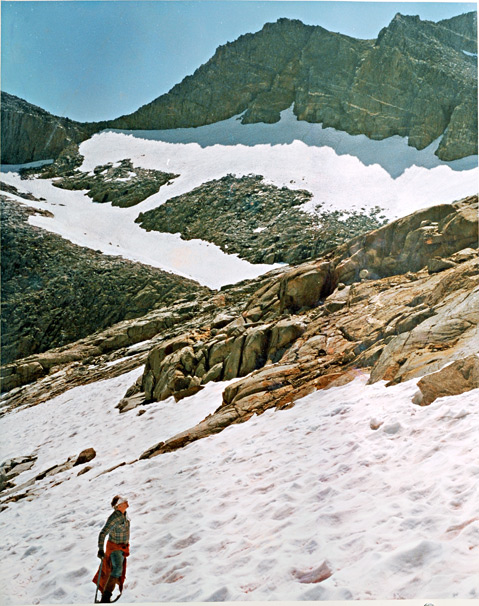Climbing a Dwindling Glacier
Trekking Mount Lyell Back When Yosemite Was Open
TREKKING MOUNT LYELL: With Yosemite National Park in the news due to the federal government shutdown, I’m tempted to hike back up to Lyell Glacier — or what’s left of it — when it reopens.
In the 30-plus years since my son Barclay and I trekked Mount Lyell’s snowy flanks, it’s been melting, not as fast as a vanilla ice cream cone in the summer Sierra sun, but melting.
Lyell Glacier’s retreat has speeded up since 2000, says Yosemite geologist Greg Stock. “Eventually, there’ll be nothing left.” But Barclay and I had no sense that we were climbing against time, on a glacier silently dwindling beneath our boots.
Scientists say the glacier will vanish in about 20 years, victim of that ol’ devil climate change. I’d be curious to compare Barclay’s photos with what we’d find there now. But although the temptation is strong, my back isn’t, and my bum right knee is on strike. From what I’ve read, there’s still snow on the mountain, but not enough for scientists to call it a glacier, strictly speaking. It’s stagnant, not moving.

I don’t recall whose idea it was to climb 13,114-foot Mt. Lyell, but that memorable summer in the early 1980s, Barclay and I decided to backpack from Tuolumne Meadows, situated at 8,600 feet above the sea, up a lovely mountain meadow along the Lyell fork of the Tuolumne River, to the foot of the craggy peak. Lyell Glacier has lost about 60 percent of its mass during the past century. In fact, scientists predict that eventually there will be no more ice left on the planet. The melt will cause oceans to rise an estimated 216 feet and engulf large portions of low-lying land, including parts of major cities, according to the September issue of National Geographic. The article graphically charts the catastrophe in the making, pointing out that while no one knows how long the Big Melt will take, some scientists figure it will be more than 5,000 years.
Which gives you plenty of time for the adventure. Don’t worry, Lyell is not a technical climb. Everest it’s not. No ropes needed. Lots of rocks to clamber over though. Just be prepared for a leisurely hike of about 12 miles along the gentle stream until you get to the base camp. There, people pitch a tent to prepare for the climb or continue backpacking beyond on the John Muir Trail.
The drive from Yosemite Valley takes you up along 39-mile Tioga Pass Road, one of the world’s great scenic auto trips, in my book. Snow closes the road in winter, so check first. Barclay and I camped out at Tuolumne the night before, collected our wilderness passes, and headed out in the morning. Not knowing what we’d need to tackle the mountain, we rented crampon spikes and ice axes. If you go, load up on mosquito lotion.
We camped for the night by the stream, where we met a young Swede who promptly managed to set his lantern on fire. Luckily, no wildfire resulted. Leaving our Swedish pal and his lantern behind, we hiked past the base camp the next day and found the glacier climbing difficult. It was studded with so-called sun cups, meaning that instead of normal walking, we had to stride from one indentation to another, quite a tiring, laborious process. The crampons were useless. Curiously, the snow was flecked with crimson algae.
These days hikers are required to lug canisters to store food, the better to keep bears from eating your dinner. But although I’ve used various pre-cylinder techniques over the years to thwart the hungry mammals, we didn’t bother on this trip for some reason and had no unwelcome guests.
It was a sunny day, with mountains rising on both sides. Mt. Lyell, highest peak in Yosemite, was named for Scottish lawyer-geologist Charles Lyell (1797-1875), quite a famous man in his day. He visited the U.S., and there are various peaks around the world named in his honor. But I found nothing to indicate that the gentleman actually climbed the Lyell glacier.
When the glacier is gone, a vital water source for Lyell Canyon will go with it, affecting plants and animals that live there now.
Even if you don’t get to the glacier, it’s a beautiful hike through a broad valley within earshot of the rippling stream. I’ve been back a couple of times for short hikes from Tuolumne Meadows, crossing short bridges over trickling creeks. Next time you’re up there, take a walk in the sun



